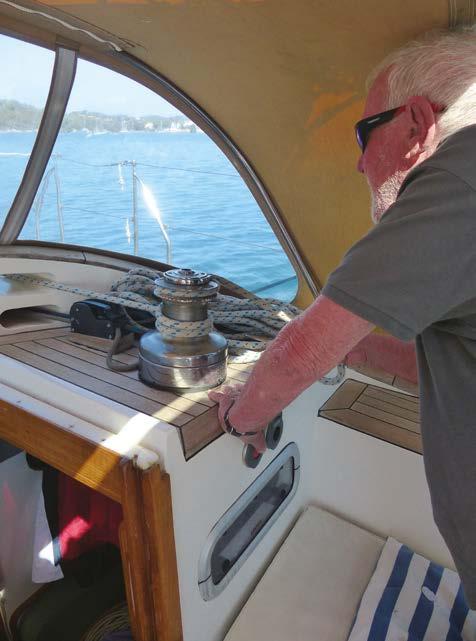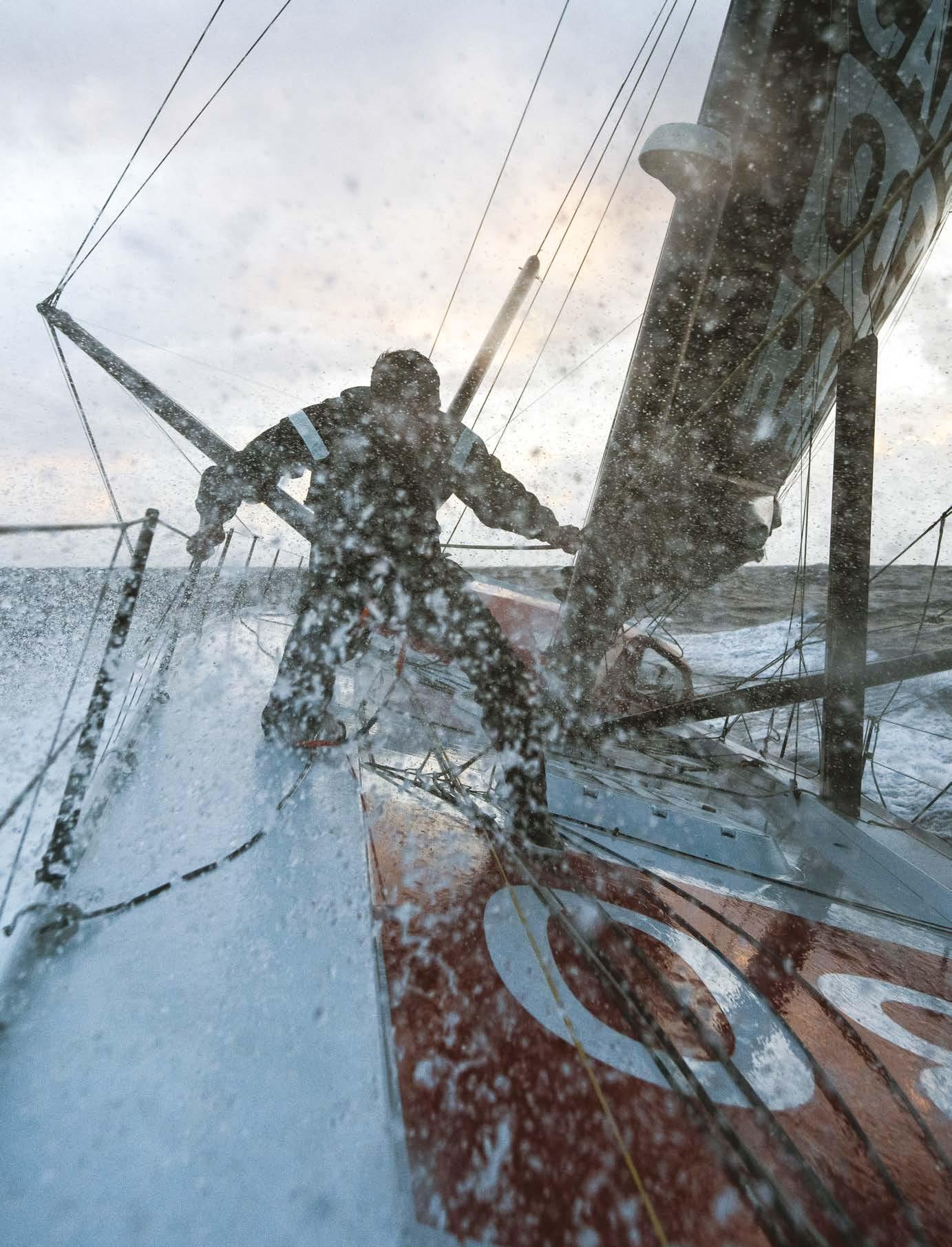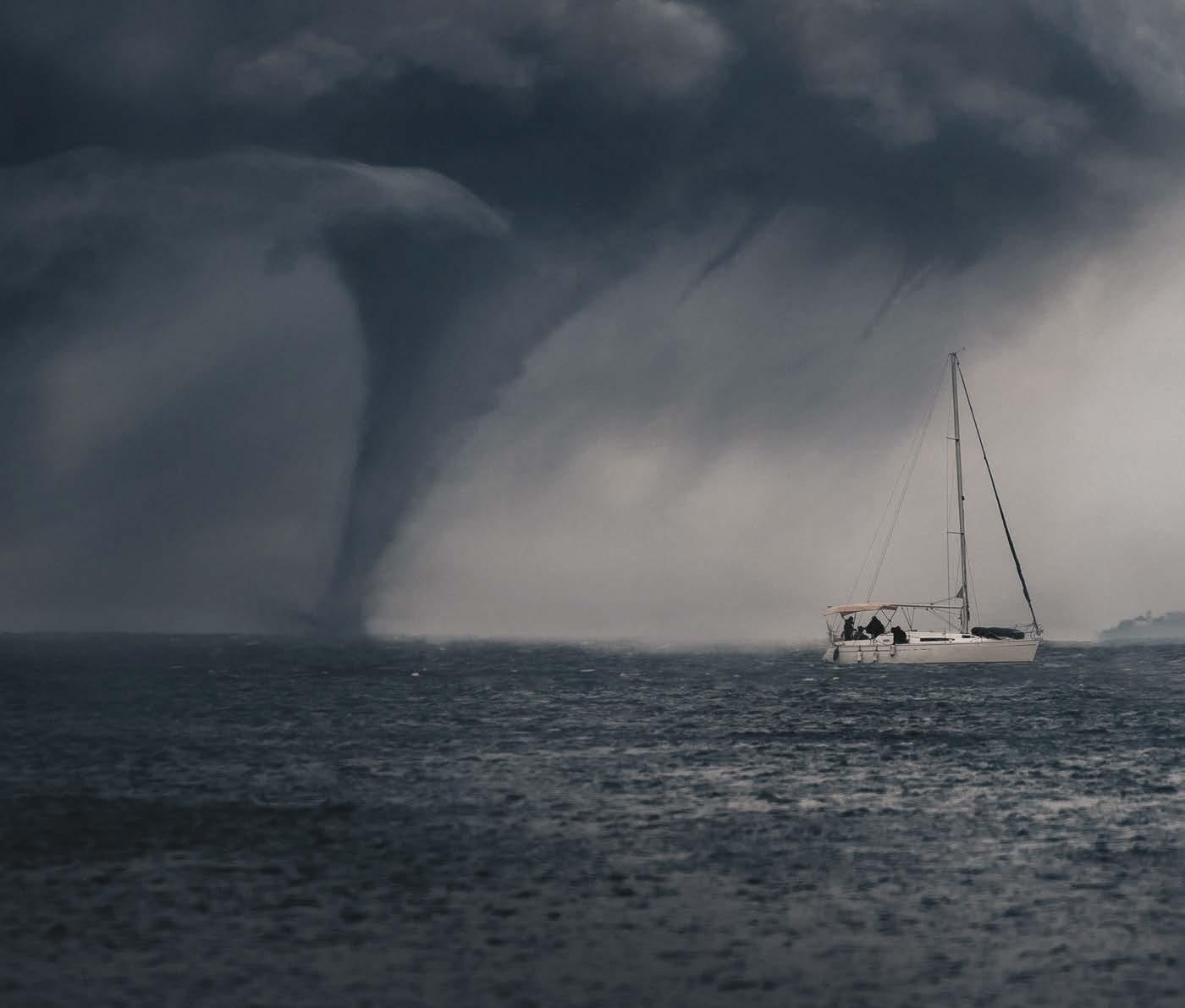
16 minute read
Heavy weather sailing
When it gets bumpy
Rod Heikell provides some pointers on heavy weather sailing techniques drawn from his extensive experiences
eaving on any passage leaves me with a dry taste in the mouth, a pile of butter ies in the stomach and a lot of ticking o of checklists. e boat is stu ed from stem to stern with enough food for four ocean passages. We have enough spares to x just about anything on board, though Sod’s Law dictates that the one spare we do need will be the one we omitted. It’s kind of endearing that, however many times we get ready for a passage, it is still a daunting experience setting o into the open sea on a small boat. e nerves get to you every time and the bravado a storm that he stopped trailing warps and let Joshua go at its own pace over the waves. Even in a heavy old boat like Joshua he could run under bare poles and safely surf over the waves keeping a sort of rhythm with the sea.
on the dock is notably muted. e one item on a check-list that all of us keep looking at is the weather and, importantly, whether there is bad weather in the o ng. Even in these days of grib forecasts, using half a dozen di erent models, the weather gods can wreak havoc. I’m pretty thorough in my research of historical weather records for an area or a passage, and we also monitor several weather websites to get a sense of what is happening. And yet it can all turn to custard, and we need to be prepared for heavy weather.
Probably my go-to tactic for heavy weather was gleaned from Moitessier’s e Long Way when he described how running before
Case 1. Tropical Storm Peter
In early December 2003 we le Las Palmas Marina on Gran Canaria heading for Guadeloupe in the Caribbean. Seven Tenths was a 36 (11m) Pedrick Cheoy Lee with three of us on board. We were ve days out when the weather began to deteriorate, and we reduced sail to run with 45-50kts of wind.
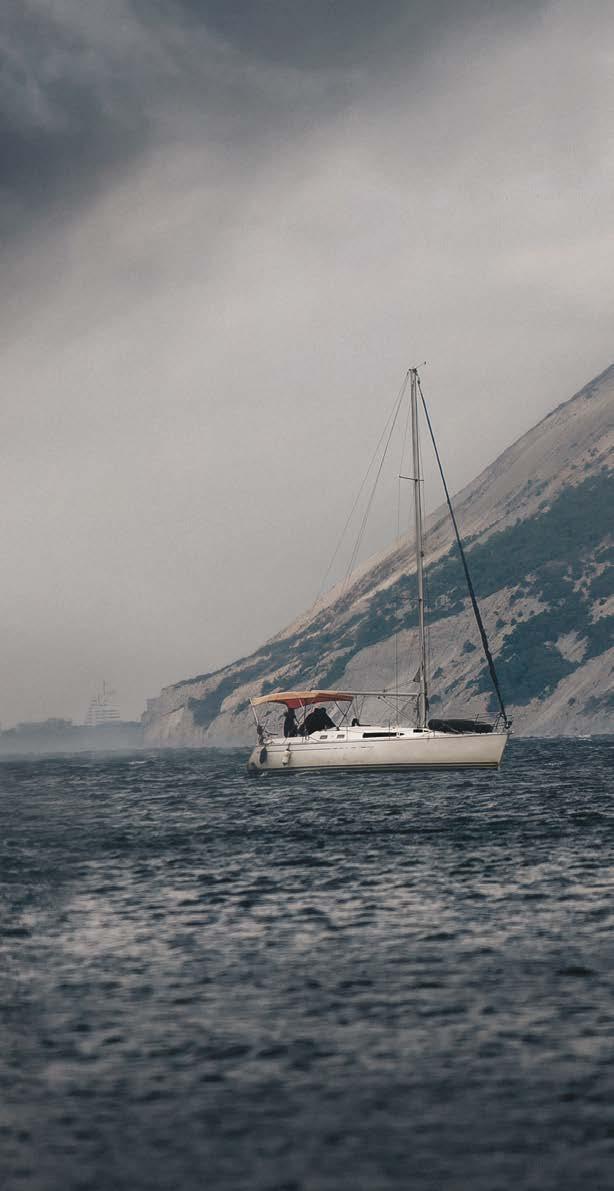
Our weather was once a day from checking in on the SSB net when an American boat ahead of us that had satellite coms would relay the forecast. As we surfed down the waves Lu got the forecast and would draw up a sort of synoptic chart and come out to tell me the bad news: “ is is tropical storm Peter and this is us”, she said showing me the chart. We were e ectively tracking the storm at about the same speed and we were squarely inside the southeast quadrant. As Seven Tenths surfed down the watery slopes of this out of season tropical storm in the Atlantic, I remember looking up in awe at the storm cells leaking lightning and
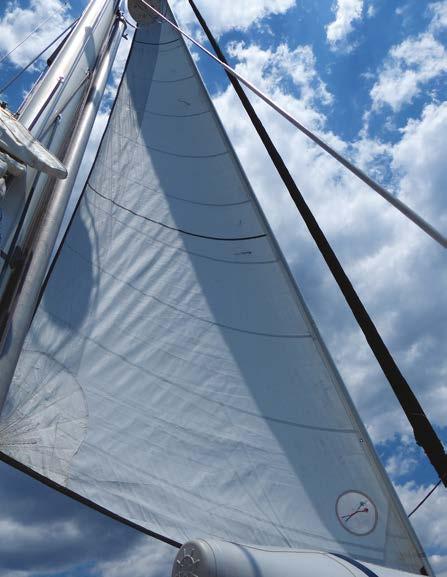
ABOVE RIGHT
A mainsail with a deep third reef has always served me better than a trysail
RIGHT
While a storm jib is a more viable option than a trysail, a staysail or even a roller furling headsail have worked for me
Trysails and storm jibs
In Antigua before setting o across the Atlantic, I suggested to the crew that they rig the storm jib and trysail that had come with the boat, while I was o doing some paperwork. When I returned three hours later, they were still struggling to get the storm jib and trysail on – and that’s in the marina.
For the last 30 years I have ordered any new slab reefing main with a deep third reef about equivalent to the size of a trysail. Ask your sailmaker to reinforce this third reef with extra cloth and added stitching. If you have a roller reefing main get the sail reinforced for the area that will be out when reefed right down. We keep this third reef rigged with reefing lines all the time, as it can be useful even in calmer weather when heaving-to, or slowing the boat down at night for a daylight entrance to a harbour or anchorage.
Whenever the weather has deteriorated to the point where a trysail and storm jib are needed, I use the main reefed down to the third reef, and either the roller reefing genny with just a bit out, or a staysail partly reefed. Modern sail material is marvellous stu compared to 20 years ago and, in most cases, the critical issues have not been the material itself, assuming it is in good condition, but stitching, fixtures and fittings. Blocks, the attachment points for reefing lines, the furling line for the headsail, cringles and reinforcement points will often break before the sail material does.
The furling line for roller reefing headsails is often a weak point when hitherto unnoticed chafe lets the whole shebang out in 50kts of wind and ,trust me, getting that lot down and tamed is intimidating.
I’m sure someone will pop up here and tell me that this is an irresponsible and unseamanlike attitude but rigging a storm jib and trysail in bad weather at sea is to my mind unseamanlike. Getting the storm jib hanked on and up on a heaving foredeck doesn’t captivate me either, but should the need arise it’s a lot easier to get the storm jib on than to get the trysail rigged.
That said headsail roller reefing systems are a lot more robust than most people think and I’ve yet to rig a storm jib in gale force winds. Let’s face it: in 50 kts of wind it’s damned di cult to hold onto flapping Terylene let alone get it hanked on and flying. In both Seven Tenths and Tetra I’ve hove-to in 5060 kts sustained with a deep-reefed main and a patch of roller reefing jib, and while I may just have been lucky to avoid damage to the sails, we all need a bit of luck out there.
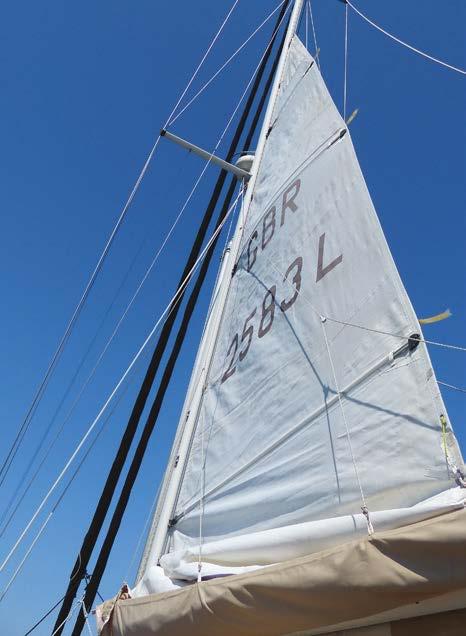
dangerous amounts of wind all over the night sky. It was scary stu and it’s di cult to describe the menace of 50kts plus of wind, and clouds full of lightning trails. Seven Tenths was behaving well with the waves but we needed to heave-to to let the storm pass.
I put the main up with its deep third reef and let a little bit of genny out on the roller ree ng, and backed the genny and magically we were hove-to. We had practiced this before but in much less wind and I was surprised at how calm things were. We still had waves breaking over the boat, but from the bows and she sat at 15 degrees or so o the wind, slowly clocking up and back o the wind. I went to my bunk a er being up for 36 hours or so and Lu and Ian kept watch.
I could be forgiven for thinking that someone up there has got it in for me. Tropical Storm Peter battered the crew of Seven Tenths as it passed close northwest of us with the wind recorded at a constant 60kts and with a de nite hurricane eye. NOAA were just about to classify it as a hurricane before it hit a cold front and petered out. e thing is that this was the rst time since 1887 that a tropical storm had been recorded in the Atlantic in December. And the irony of it all was that Lu and I were going to the Caribbean to get married. My future fatherin-law was called Peter. e lessons are plain: Bad weather can brew up at odd times of the year, especially with climate change a ecting things. Running o is an ok tactic but not with tropical storms and hurricanes where you need to get out of the way of the system and head for the equator. And that deep third reef proved its worth yet again.
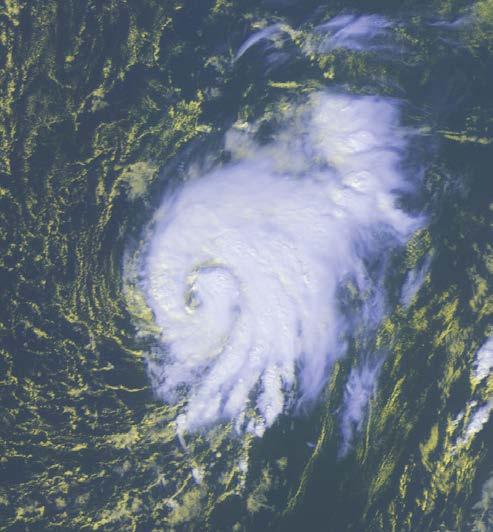
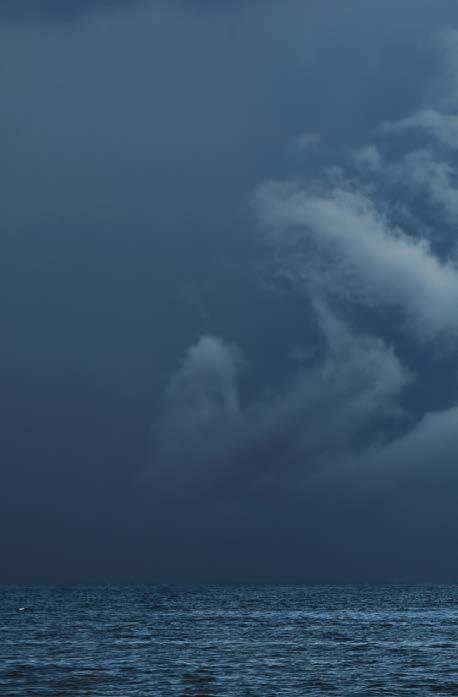
ABOVE
Tropical Storm Peter roaring across the Atlantic
BELOW
Seven Tenths in calmer conditions preparing to weather an Atlantic squall
Case 2: 60kt system in the Paci c
In mid-Paci c on our way to Palmerston Island, I noticed the wind speed was creeping up over 30kts. Lu had just gone o -watch and was not best amused at being called up, until she looked out the back at the evil greeny-grey cloud stretching right across the horizon. Time to reef the main I said while reducing the roller-ree ng genny. By the time Lu was up at the main, the wind speed was up over 40kts
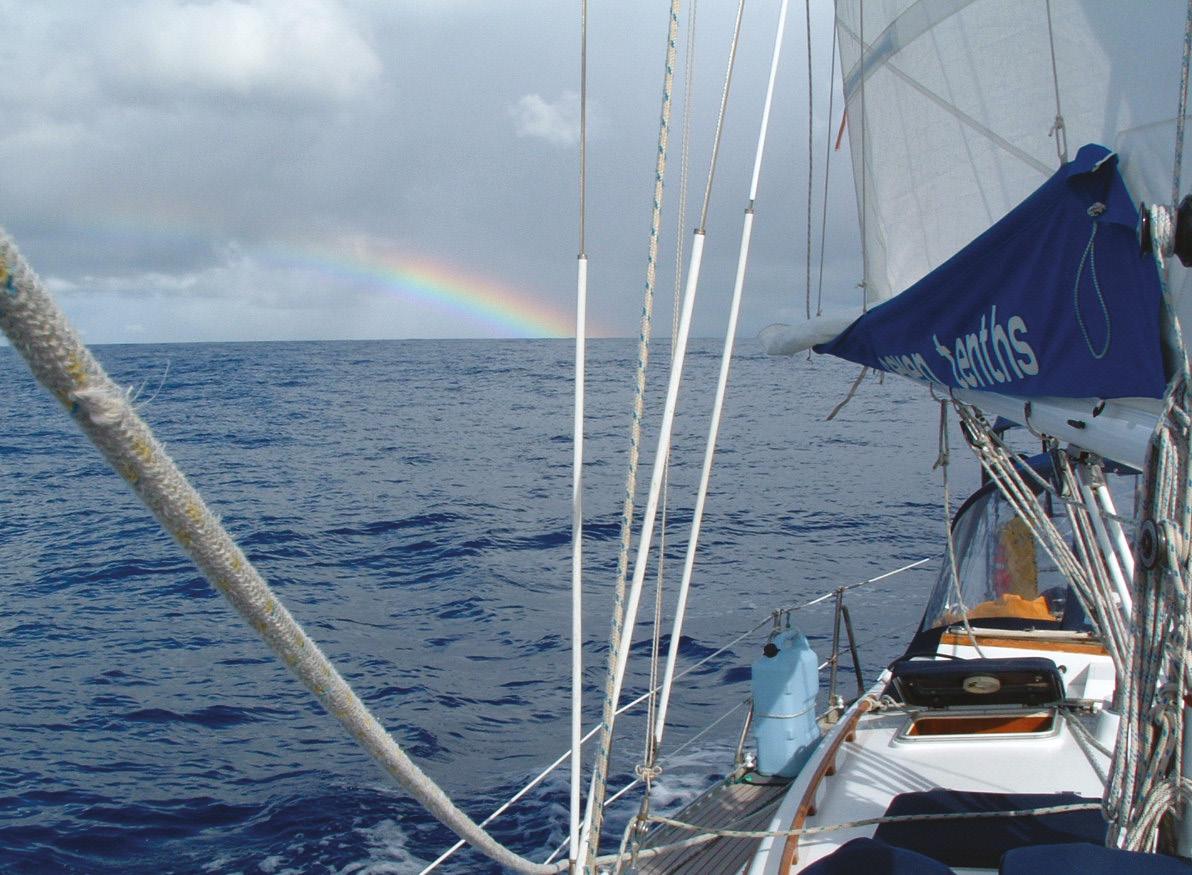
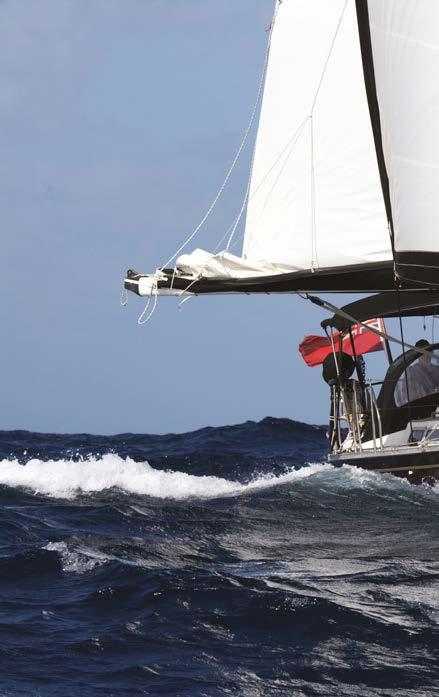
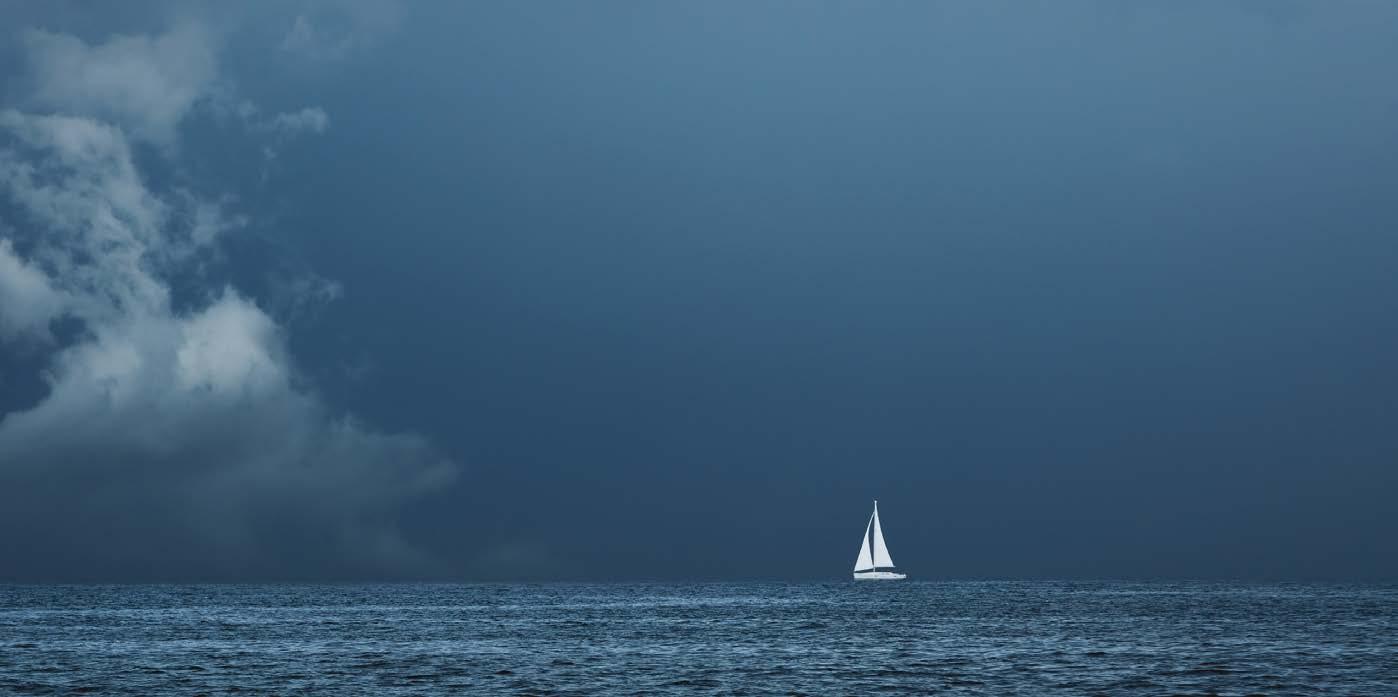
and, as she wrestled the main down the wind speed kept going up. Time to get rid of it all together.
Once Lu had tamed the main the wind was over 50kts and climbing. I rolled up the genny completely and we scooted along under bare poles at 7-8kts with the wind at 60kts plus. We donned life jackets and harnesses – I know, but better late than never – and steered Skylax directly downwind. A er a couple of hours, the wind was down to 50kts and then 40kts. Strange how 40kts and dropping is a relief a er so much wind. I remember reading in Moitessier’s e Long Way that the art now is to keep letting out a bit of sail, usually the roller ree ng genoa, to keep the boat going fast enough so it is not pooped by the sea that has built up.
We still got a couple of wavefulls into the cockpit, where the biggest annoyance was the cockpit cushions floating around our shins. And I was worried about the engine start panel in the cockpit, which had been underwater a few times from the waves washing in. As it turned out it was ok except it lost its buzzer when you turned the ignition on.
We got off lightly. The middle sprayhood was knocked flat. The MOB aid on the transom was washed away. But apart from everything in the cockpit getting drenched, we were ok. After four hours we were back to full genny and a double reefed main, on our way to Palmerston Island.
BELOW LEFT
Skylax in brisk trade wind conditions – two reefs in the main and a partially furled genoa
BELOW RIGHT
Hustling along in the Paci c
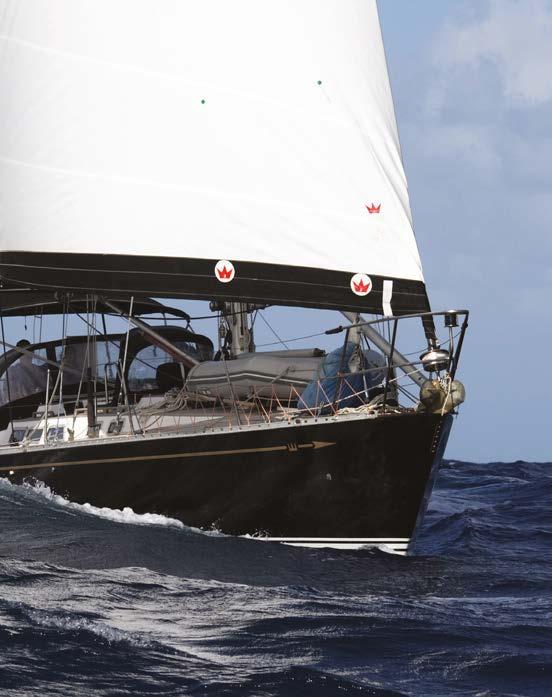
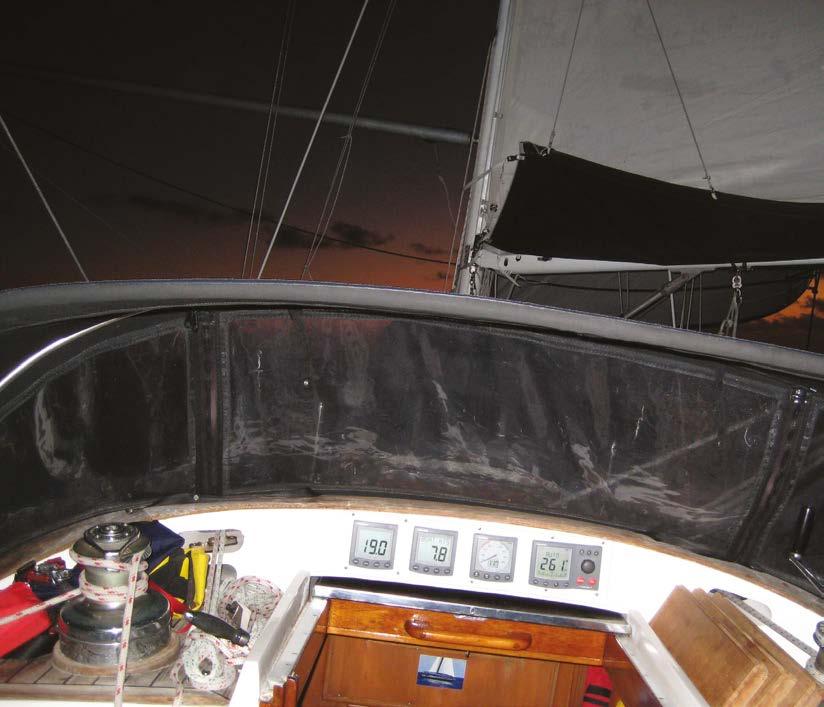
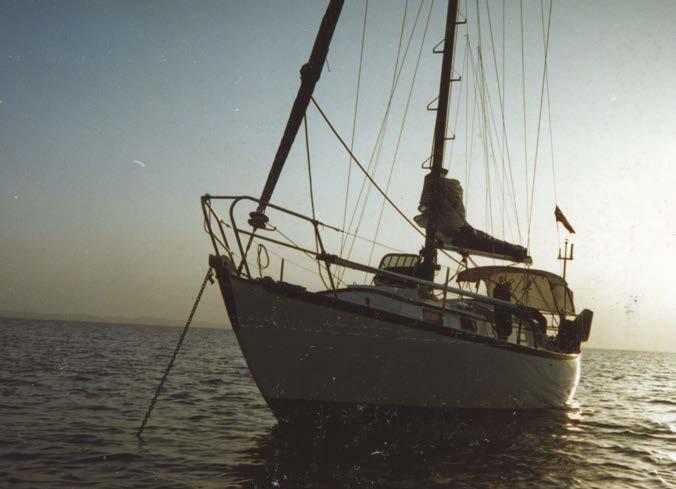
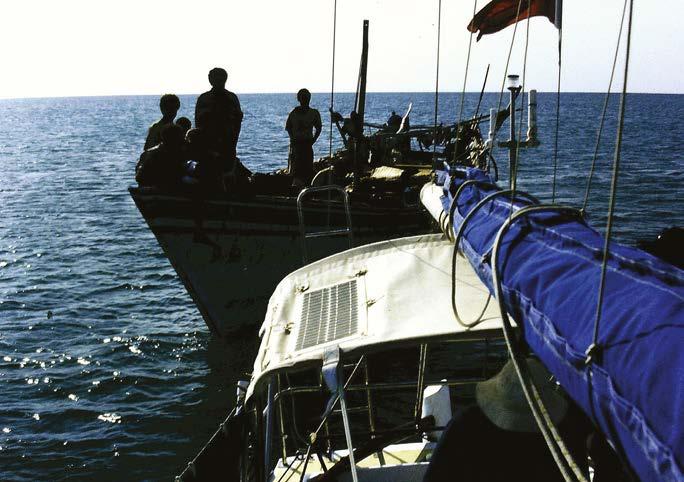
Case 3 Getting out of the Gate of Tears.
Sometimes it is not the sheer force of the wind that makes a voyage hard going but the overall situation visà-vis wind, the season and current. We were at the bottom of the Red Sea getting out of Bab El Mandeb, the Gate of Tears, at the wrong time of year with a war going on aswell. Bab El Mandeb is the southern entrance to the Red Sea with the small channel on the east side and the main channel, including the shipping channel with separation zones, between the Yemeni island of Mayyun with a coastguard station on it and the Djibouti coast on the other side. Currents mostly ow northwards here, but there are tidal streams as well that will increase or decrease the current.
‘ is is the BBC World Service. ere are reports that Eritrea has invaded the Hanish Islands near the bottom of the Red Sea and occupied Greater Hanish Island. A number of Yemeni soldiers manning the garrison have been killed and the commander of the Eritrean force reports that 80 soldiers have been taken prisoner. e Yemeni government is sending forces to repel the invading force including a number of naval cra and Mig ghters.’ None of us said anything but just looked at each other as we tacked towards the Yemen coast under Greater Hanish. We had spent ve days in the anchorage at the top of the island wistfully hoping the strong southerlies of 30-35kts would die down a little. Partly because we were getting frustrated at just sitting there and partly because Colin had to y back to London, we had decided to buckle down and beat to windward whatever the wind gods were doing in this part of the world. Now it seemed there was going to be a bit of a war as well.
I had le Turkey in September and sailed Tetra down to Cyprus where Colin and Frank were to join me. Tetra is an old fashioned, long keel yacht built by Cheverton on the Isle of Wight in 1962 and, at just 31 , a rather small yacht for this sort of voyage against the prevailing wind and current. Once through the Suez Canal we pottered around the coast a bit before picking up a good northerly blow, reaching Massawa in Eretria in something under ve days. Even loaded down, the old lady had averaged 130 plus mile days. e problem was that I knew that the wind and current would likely be against us from then on, but only in theory. e bruising reality of beating to windward in 30kts and against the current meant that a day’s run was lucky to be 50 miles and it was di cult to sleep, eat or do anything except wedge yourself in the cockpit and turn your head away as green water cascaded over the deck and into the cockpit. ere were times I wished for 150 of ocean-going motor yacht instead of 31 of old-fashioned sailing yacht. Our worst patch was 12 miles made good in 10 hours, but eventually we made the small strait on the east side of Bab el Mandeb and, as we passed through the Gate of Tears, we had our own personal version of why it was called thus and it had nothing to do with sorrow at leaving the bottom of the Red Sea.
In the bumpy bits at the bottom of the Red Sea I had rashly promised all sorts of things to Colin and Frank to keep our spirits up. Amongst these promises was a slap-up meal with all the beer they could drink. e thing
ABOVE LEFT
Tetra in the Red Sea
ABOVE RIGHT
A shing dhow in the Hanish Islands tied up alongside Tetra
BELOW LEFT
We always make a libation to the wind and sea gods wherever we go
BELOW RIGHT
In Aden a er nally escaping through the Gate of Tears
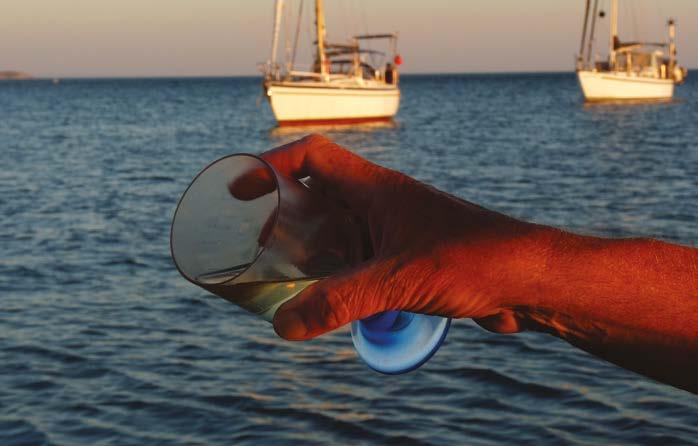

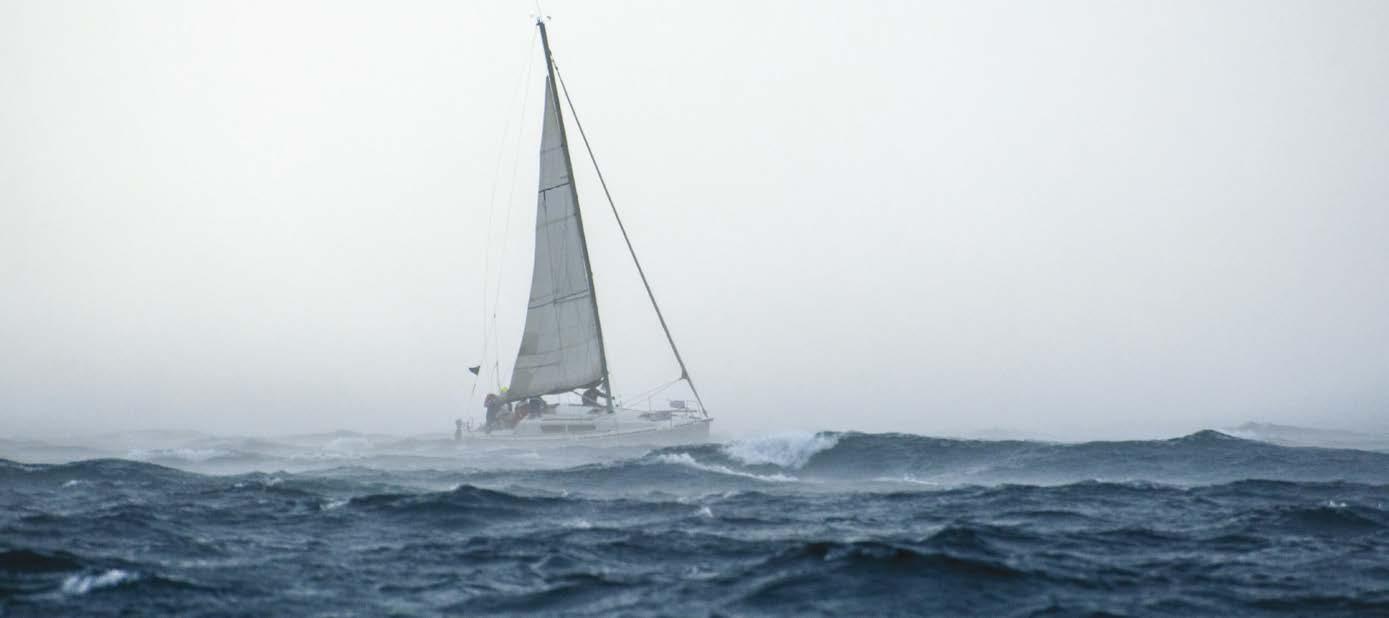
is, nobody had mentioned that in the last war in 1994, the north had won and being more fundamentally minded than the south, alcohol was banned. Except for a few of the large hotels where beer was $5 for a small can. It was an expensive promise but a er the bruising experience of getting out of e Gate of Tears I was more than happy to pay up and more than happy I had ordered new sails for Tetra including a main with a deep third reef in it.
Bad weather
None of us wants it and, in practice, you are unlikely to experience bad weather when sailing in the right season for a stretch of ocean. Most damage comes from squalls where the wind speed may peak at 40-50kts for a short time, o en accompanied by the wind veering dramatically. As long as you keep an eye out astern for squalls, and reef down before one arrives, then you will likely avoid damage. It is the gung-ho sailor who keeps all white sails up in a squall who will come to grief. Normally this will just be sail damage, though it is also possible to damage the rig. at said, there can be occasions when sustained bad weather does happen at sea and skipper and crew need to have a bit of an idea on what to do. I say a bit of an idea because we all have scenarios we have read, on dealing with heavy weather, but in practice things can be a little more uid and involve more guesswork than following a recipe of what to do in gale force winds. From my experience, the following has worked ok up until now.
As long as you have sea room, run o before the gale. Reduce all sail except for a bit of jib or put up the storm jib and run with the wind. You will likely have to hand steer so make sure you are clipped on. Even under bare poles I’ve done 7-8kts in winds up to 50-55kts with a reasonable amount of control. What is important, is to start increasing sail area as the wind begins to drop and the by now big waves start to collapse on the top. You need to keep speed up to avoid being badly pooped by these collapsing waves. ere are those who are fans of a sea anchor let go from either the stern or the bows. I’ve had no experience of these and gured if I was running o downwind I could always trail warps and the kedge anchor we keep on the pushpit.
If running o is not an option, or is the wrong option for other reasons then I usually heave-to. With a deep third reef in the main and a scrap of backed jib, you can tie the helm o so the boat fore-reaches into the wind and importantly into the seas. Depending on the boat, you can be anything from 20-60 degrees o the wind. My previous boat Seven Tenths, a Cheoy Lee Pedrick 36 was ‘better’ at heaving-to than my present boat Skylax, a Warwick Cardinal 46. Being hove-to is remarkably calm and you are meeting the seas with the sharp end of the boat, which just seems a better way to do it.
Lying ahull has never worked for me. e boat tends to lie across the seas and the waves smash into the hull with some force, forcing the boat over every time a wave hits. In really big seas it seems to me there is the danger of a B2 knockdown and I have only ever tried lying ahull in 35-40kts a couple of times. It is not my preferred option.
Books have been written about dealing with heavy weather so this is no more than an outline, but I will stress again that you are unlikely to encounter a full gale at sea if you are in the right stretch of water in the right season. You will always encounter gale force winds for a short duration when squalls come through.
ABOVE
Weathering the squalls
BELOW
A retro tted electric winch can make life a lot easier in heavy weather
